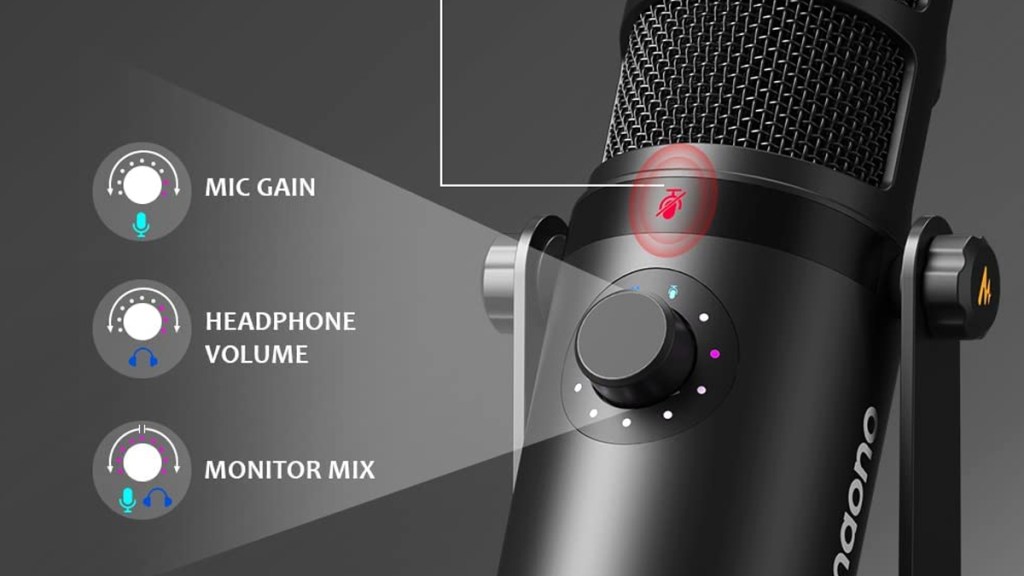It’s clear that the Maono PD400X microphone is taking aim at super-popular USB/XLR hybrid mics like the Shure MV7. Only, the PD400X comes in at a much cheaper price. While it might not have the brand recognition that Shure does, when it comes down to the hardware and accompanying app, the battle is impressively close.
Armed and ready

With the PD400X unboxing experience, Maono sets itself up as a clear contender. Joining the mic in the box is a windscreen, a small desktop stand, USB-C to USB-A cable, an XLR cable, and a quick start guide.
Buy the Maono PD400X on Amazon.com here
It’s a good first impression, even for a more budget-oriented mic like this. The PD400X looks sleek with its all-black design and is subtle enough so as not to be distracting on-camera like some microphones can be.
Standing tall

While the included stand isn’t ideal for home recording, it is still nice to see, especially when you consider the PD400X’s potential portability with its USB-C connection. I can see myself using the included small stand when I need to record on the road.
Ideally, though, this mic will be attached to a boom arm. Thankfully, this is made easy with compatibility for ⅜” and ⅝” threads.
Two options

The main highlight of the PD400X is its dual functionality. It supports both a USB and XLR connection. This makes it great for those looking to use USB now with a plan to upgrade to an XLR setup later, or for those, like me, who can make use of XLR at home and then turn to USB when recording away from my home setup.
While real-time headphone monitoring is achieved through the bottom 3.5 mm port, opting for a USB connection unlocks a range of additional features. The 3-in-1 knob, for example, controls microphone gain, headphone volume, and monitor ratio. Pushing it in changes which setting is being adjusted.
Pushing buttons

Connecting via USB also enables a touch mute switch, with muting and unmuting the mic easily achieved through lightly tapping the power light. This is green when unmuted and red when muted. A tap is so much better than a button push, as it’s much less likely to transmit unwanted noise.
Another button on the bottom of the mic controls EQ settings. It’s flat by default, but users can switch between a high-pass filter, presence boost, or both with a simple click. Changing on-the-fly like this is very convenient as you don’t have to dive into any software.
Unfortunately, while the rotating knob feels great to use, the EQ button on my unit is less responsive. I’ll often have to press it multiple times to get the EQ setting to change. Thankfully, I don’t have to push this button much.
Apply yourself
For those that do want to dive into software, there is “Maono Link.” This supporting app allows for the tuning of the mic gain, volume, and EQ settings that can also be achieved with the knobs on the mic, in addition to a limiter and compressor.
Much like the Shure MV7 that is not-so-subtly mirroring, the PD400X has a robust app that can make an already good-sounding mic sound great.
Of course, the audio quality can be ramped up even further by making use of the XLR connection and adding the PD400X to a chain of impressive audio production gear, once users are ready to jump into that world.
PD400X review sample provided by Maono.
Final Verdict
At $169 (though it’s $149 at the time of writing), the Maono PD400X will be incredibly tempting to those looking at the $249 Shure MV7 and wondering if they can save a chunk of change by going with this less-known brand.
The good news is that I’ve found that they sound pretty darn similar, especially when tuned with EQ. The PD400X might be weaker at rejecting plosives, and I can hear a little bit of distortion in the mid-bass at times, but those minor niggles are far from deal-breakers when you consider the low price.
Those looking for a dual-functionality mic at under $200 should definitely look into the PD400X.
Positives and Negatives
-
Dual-functionality is awesome.
-
Great sound quality through USB and only gets better when enhanced via XLR.
-
Looks great.
-
Generous on-mic controls.
-
Supporting app adds a limiter and compressor that work well.
-
EQ button is inconsistent.
-
Weak plosive rejection, though included windscreen helps.











